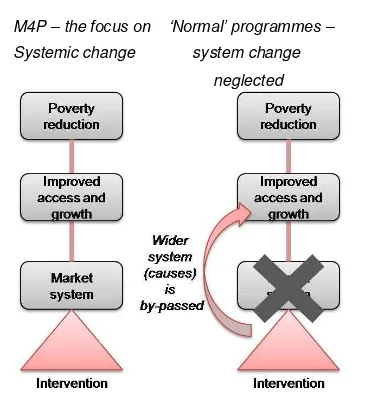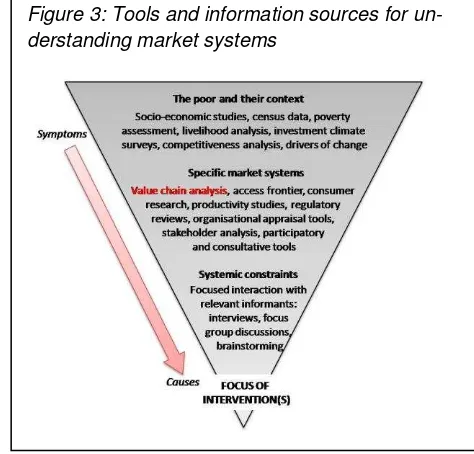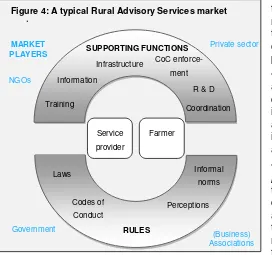Making Markets work for the Poor (M4P):
a strategic framework for achieving aid
effectiveness
An introduction with emphasis to linkage between
M4P and rural advisory services (RAS)
Input paper for joint event of ARD and E+I networks of SDC
3
rdMay 2012
Matthias Herr
Helvetas Swiss Intercooperation
April 2012
1
Table of contents
1. What is M4P? ... 2
2. How is M4P different? ... 3
3. What has been the experience of M4P in practice? ... 4
4. How do M4P and RAS go together? ... 4
2
1.
What is M4P?
The M4P approach provides a strategic framework for projects in different development fields to think about and conceptualise aid effectiveness in a more systematic manner. It provides principles and frameworks along a typical project cycle that support the objective of achieving large-scale and sustainable impact on the target population.
Known in full as the ‘Making Markets Work for the Poor’ (M4P) approach, and predominantly applied
in the field of private sector development, it is critical to understand that principles and frameworks offered by the approach are valid for other development fields as well, such as health, education, water, governance, gender – or rural advisory services. The term ‘market’ refers here to a rather
broader notion of ‘transactions’, which form the basis of all human interaction.
The M4P approach is defined by a number of important characteristics:
An approach: M4P is an approach to development that provides guidance not only on understand-ing of the poor in market systems (analysis) but on how to brunderstand-ing about effective change (action). Analysis should identify the underlying constraints impinging upon market systems and concentrate on addressing these.
Systemic focus: its focus is on developing market systems, assessed with respect to different func-tions and players, public and private, formal and informal. This systemic character of M4P defines many of its most important features. Its view of a market system (Figure 1) emphasises their multi-function, multi-player nature – in particular the three main sets of functions that make up the market
system:
the core function between de-mand and supply which constitutes the key transaction that the project is inter-ested in (or the series of players in a value chain),
the formal and informal rules im-pinging on shaping behaviour and
the information, services and other functions supporting exchange. This systemic view of markets is not only relevant to commercial markets (e.g.
in-dustry or agriculture), but also to ‘ma
r-kets’ that are seen traditionally as pu b-lic/government domain.
Large-scale change: by addressing underlying causes (rather than symptoms) of weak perform-ance, M4P aims to unleash large-scale change. Interventions may be small in themselves, but should continually strive to leverage the actions of key players to bring about extensive change.
Sustainability is a prime concern of M4P. This means considering not just the existing alignment of key functions and players but how they can work more effectively in the future, based on the incen-tives and capacities of players to play different roles. For projects this means in particular looking at how core functions in system and continuous improvement of the regulatory and policy environment can be sustained in the long-run without external support.
Facilitating role: M4P requires that (development) projects play a facilitating role. As external play-ers they seek to catalyse othplay-ers in the market system (while not becoming part of it themselves). M4P emphasises explicitly that the role of intervention is temporary and catalytic. Projects should avoid performing important roles directly (neither in the core nor as supporting function) and try to facilitate players to perform more effectively.
3 Interventions therefore need to be sensitive to local market conditions and seek to stimulate deeper
and larger change by ‘crowding in’ other players to improve the functioning of the market system.
Successful facilitation, although not a fixed model, requires organisations that have credibility, inde-pendence and relevant knowledge and skill.
2.
How is M4P different?
The above characteristics define M4P and clarify its difference from ‘conventional’ approaches – as summarised in below:
Characteristic M4P Conventional
An approach Combines coherent rationale, analytical framework and guidance for action applicable in different market systems
Different frameworks and good practice guides. Often disconnect between analysis and ac-tions.
Market system focus
Priority and focus on changing systems, driven by detailed understanding of underlying constraints (causes).
Focus on addressing firm-level problems rather underlying causes of those problems (see
Figure 2)
Large-scale change
Priority is to identify and address system con-straints that can leverage wider change
‘crowding-in’ other players and activity.
Limited scale of impact because of reliance on direct support. More impact needs continual infusion of more aid resources.
Sustainability Explicit consideration of the alignment of roles and players (and incentives and capacities) in market systems - now and in the future.
Limited view of sustainability – often of direct not be part of market system in longer-term.
Often a very direct provider role in market that, while achieving in short-term, distorts market systems and increases their reliance on aid.
Many of the distinctive features of M4P are manifested in its ‘systemic’ character. As Figure 2 below
illustrates, conventional approaches commonly ‘miss’ the means through which growth and access
is achieved – i.e. they seek to provide directly to target beneficiaries.
Conventionally, projects’ instinct has been to ask the question “what problems does the target popu-lation have and how can I solve them?” and not to ask the more relevant systemic questions: “why
isn’t the market environment/the system providing
solu-tions?” to these and “How can I address the constraints that prevent it from effectively doing so?” Similarly, gov-ernments often throw money at problems, provide direct solutions or invite development agencies and NGOs to solve the problem for them – rather than identifying and addressing underlying systemic causes of problems.
By addressing the market systems within which the target population operates M4P focuses on underlying causes and therefore the potential triggers for sustainability and large-scale impact. M4P permits agencies and govern-ments to raise the limit of their ambition. For example, in relation to services and inputs for farmers: while a conven-tional project might concentrate on providing or subsidis-ing these directly, M4P would focus on improvsubsidis-ing the sys-tems that provide inputs. Putting M4P into practice also requires different operational capacities and approaches – for example in relation to skills, relationships, intervention design and implementation and project set-up.
Figure 2: Different impact logic: M4P and conventional projects
4
3.
What has been the experience of M4P in practice?
There is growing evidence that M4P works. Major projects, in different contexts and sectors explicitly using the M4P approach, and governments and agencies influenced by its key tenets, have achieved significant change.
Change is manifested in high levels of outreach and impact – for example, the number of people accessing and benefitting from new services. More important, in each case, the capacity and incentives have been developed to show that change is sustainable and therefore impact will grow further in the future.
For example, in Asia, Katalyst in Bangladesh has stimulated new information flows in agricul-ture supply chains reaching around one million farmers (which is also a typical objective of RAS projects); together with its implementing partner RTM International and the Ministry of Health, it is also initiated wider change in the healthcare system by allowing private sector to crowd-into the training of health workers. In South Africa, FinMark has contributed signifi-cantly to the development of an expanded and
more inclusive financial services market with reach growing from 38% to 60% in a five-year period. And in Uganda, small business-focused radio programmes now reach more than 7m radio listeners from a base of zero.
Beyond these few examples, in sectors as diverse as healthcare (China and Bangladesh), water and sanitation (many countries), palm oil (Thailand), land and property (South Africa), (remote) rural live-stock and fruit development (Armenia) and manufacturing (Bangladesh), there is evidence of suc-cessful application of the ideas of M4P, even if these are not always labelled M4P projects per se.
SDC has been at the forefront of developing, applying and promoting the M4P approach. An increas-ing number of projects are usincreas-ing the M4P approach to guide them in development interventions, some of which are in fact implemented by local partner organisations, thereby hoping to build the capacity of these organisations in the implementation effective development interventions. Internally, the E+I Network continues to function, and organises events that aim at bringing the M4P approach forward – for example in Latin America.
4.
How do M4P and RAS go together?
There often exists the perception that rural advisory services (RAS1) – or even value chain develop-ment (VCD) – and M4P are two different and even competing approaches (i.e. a project using either one or the other). In fact, M4P and RAS are not substitutes for one another, but complementary – the one builds on the other: M4P sets out the overall framework conditions under which the RAS are applied. Today, RAS are understood much wider than agricultural extension and go beyond the transfer of technical know-how for agricultural production: e.g. from agricultural extension to agricul-tural knowledge and innovation and systems, and RAS with a market orientation. RAS are provided
1 Definition of RAS according to GFRAS (2011): Rural advisory services are all the different activities that provide the
information and services needed and demanded by farmers and other actors in rural settings to assist them in developing their own technical, organisational, and management skills and practices so as to improve their livelihoods and well-being.
5 by public and/or private players, they are formal and/or informal, embedded within transactions (in-put supply, purchase of farm produce) and/or for-fee services – hence pluralistic.
M4P frameworks and principles provide a useful tool for RAS projects to think about large-scale and sustainable solutions. Figure 4 for example illustrates how an M4P market system diagram can be applied to rural advisory services, helping projects to analyse and understand the functions and players that constitute an effective and pluralistic system of rural advisory services:
The core transaction concerns the exchange of for example productivity related information between farmers on the one side and service providers on the other (e.g. government extension, private providers, input suppliers etc.).
A variety of functions and rules are necessary to support such an ex-change of information. For example: train-ing of service providers, coordination amongst farmers, quality standards for information provision, access to finance as means of financing such services etc.
Therefore there are a number of public and private players involved in a typical RAS system – for example: asso-ciations of service providers for quality assurance, government institutions for training of service providers, private busi-nesses or input retailers that provide in-formation to farmers etc..
Merely the application of the M4P market system framework (Figure 1) to a typical RAS system, illustrates the usefulness of this framework – but also the importance of RAS projects to develop an understanding of the wider system necessary to support RAS in a given context: a RAS project can-not perform functions in the system itself (such as training) if these are critical to the sustainable functioning of the RAS system. RAS projects need to stimulate different local players to take on more valid roles in the RAS system. They need to act as facilitators in order o achieve sustainable change in the RAS system as well as large-scale impact on the intended target population (e.g. farmers).
Hence the M4P principles and frameworks are applicable to and valid for RAS projects in order to achieve improved effectiveness.
5.
Further reading on M4P
More information on M4P is available from three publications sponsored by SDC and DFID:
A Synthesis of the Making Markets Work for the Poor (M4P) Approach
Perspectives on the Making Markets Work for the Poor (M4P) Approach
The Operational Guide to Making Markets Work for the Poor (M4P) Approach
These are available for download at http://www.m4phub.org/. They also contain reference to further publications such as case studies. The website of the M4P Hub (which acts as a coordination body for people and organisations interested in the M4P approach) also provides access to a variety of other documents and experiences. For further reading see also: http://www.value-chains.org/dyn/bds/docs/detail/681/6; and: http://snipurl.com/21w0k12
This paper has been adapted from an input paper submitted by The Springfield Centre for the SDC E+I e-learning cycle in 2010. More information can be obtained from www.springfieldcentre.com.
Service


